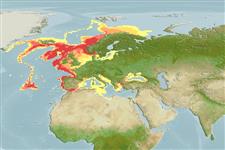Common names from other countries
Environment: milieu / climate zone / depth range / distribution range
Οικολογία
; εύρος βάθους 1 - 1829 m (Ref. 85345), usually 50 - 400 m (Ref. 125144). Subtropical; 72°N - 9°N, 19°W - 37°E
Northeast Atlantic, Eastern Central Atlantic and the Mediterranean.
Length at first maturity / Μέγεθος / Βάρος / Age
Maturity: Lm ? range ? - ? cm
Depth based on occurrence (Ref. 2851, p. 719); to be replaced with better reference. Occurs in fine sand and silt substrate at depths between 50 to 200 m (Ref. 96391). Epibenthic (Ref. 87524) and free-living (Refs. 3123, 96391).
Life cycle and mating behavior
Γεννητική Ωρίμανση | Αναπαραγωγή | Γεννοβολία | Αβγά | Γονιμότητα | Προνύμφες
Members of the class Asteroidea exhibit both asexual (regeneration and clonal) and sexual (gonochoric) means of reproduction. Life cycle: Embryos hatch into planktonic larvae and later metamorphose into pentamorous juveniles which develop into young sea stars with stubby arms.
Alves, F., L. Chicharo, A. Nogueira and J. Regala. 2003. (Ref. 2851)
IUCN Red List Status (Ref. 130435)
CITES status (Ref. 108899)
Not Evaluated
Not Evaluated
Human uses
| FishSource |
Εργαλεία
Περισσότερες πληροφορίες
Age/SizeΑύξησηLength-weightLength-lengthΜορφολογίαΠρονύμφεςΑφθονία
Διαδικτυακές πηγές
Estimates based on models
Preferred temperature
(Ref.
115969): 1.7 - 10.5, mean 7.1 (based on 112 cells).
Price category
Unknown.
